With a diverse ecosystem of rivers, forests, and mountains, Arkansas is a haven for bird enthusiasts and nature lovers alike. Among the state’s most impressive winged residents are the hawks, symbols of power and freedom, whose presence contributes to the rich biodiversity of Arkansas.
Whether soaring high in the open sky or perched silently on a lofty branch, hawks in Arkansas captivate the attention of locals and visitors with their majestic beauty and unparalleled hunting prowess.
Types of Hawks in Arkansas
1. Red-tailed Hawk – Easily identifiable by its reddish tail, it can often be seen soaring over highways and fields across the state, including the expansive terrain of Ouachita National Forest.
2. Cooper’s Hawk – Cooper’s Hawks have a preference for dense woodlands, they can frequently be spotted in wooded suburban areas and forests, particularly in the Ozark National Forest region.
3. Red-shouldered Hawk – Red-shouldered Hawks thrive in wet, deciduous forests and can be spotted in areas such as the Mammoth Spring State Park and along the Buffalo National River.
4. Sharp-shinned Hawk – Sharp-shinned Hawks are slightly less common in Arkansas but can still be found in forested areas, often zooming through dense trees in pursuit of their prey.
5. Broad-winged Hawk – Broad-winged Hawks are migratory visitors to Arkansas, usually seen during their spring and fall migration. Broad winged hawks breed and can be observed in higher numbers in areas like the Hobbs State Park-Conservation Area during these periods.
6. Northern Harrier – Northern Harriers, identifiable by their distinctive flight pattern, are primarily seen in Arkansas’ open fields and marshes, such as the wetlands in Holla Bend National Wildlife Refuge.
7. Swainson’s Hawk – Swainson’s Hawks are less common in Arkansas but can be seen during their migration. They tend to favor open habitats, including agricultural fields and prairies.
8. Ferruginous Hawk – Ferruginous Hawks are not commonly seen in Arkansas, but occasional sightings do occur, usually in the winter months, often in open grassland areas.
9. Northern Goshawk – Northern Goshawks are rare in Arkansas, but they have been occasionally sighted, particularly during the winter. Their preferred habitat includes mature, extensive forests.
10. Rough-legged Hawk – Rough-legged Hawks are winter visitors to Arkansas, typically seen in open fields and farmlands. Their presence is less frequent compared to other medium sized birds species in the state.
Where to Spot Hawks in Arkansas
Ouachita National Forest: As the oldest National Forest in the southern United States, Ouachita provides a diverse habitat supporting a variety of hawk species, including the Red-tailed and Cooper’s Hawks. The sprawling forest offers plenty of observation points for enthusiastic bird watchers.
Ozark National Forest: Covering over a million acres of land, the Ozark National Forest is a haven for numerous bird species. Its mixed terrain of woodlands and hillsides is an ideal habitat for hawks like the Red-shouldered and Sharp-shinned Hawks.
Buffalo National River: This area, particularly the river’s upper district, is a wonderful place to spot migrating Broad-winged Hawks during spring and fall.
Holla Bend National Wildlife Refuge: An important habitat for wintering birds, Holla Bend presents opportunities to spot Northern Harriers and occasional Ferruginous Hawks in the open wetlands.
Your immersion into the world of raptors takes a flight beyond the Red-tailed Hawks of Arkansas, introducing a breathtaking tableau of hawk-watching experiences across neighboring landscapes. Venture west, and Oklahoma’s Red-tailed Hawks will captivate you as they command the state’s sprawling plains. Travel east, and the Broad-winged Hawks of Tennessee await, their mesmerizing flights providing unforgettable encounters in the state’s varied forests.
To the south, let the allure of Louisiana’s Red-shouldered Hawks draw you into the enchanting heartland of the bayou. Each adventure serves as a vibrant thread in the fascinating narrative of our comprehensive guide to hawks across the United States, beckoning explorers to continue their exploration of these magnificent birds.
Arkansas Hawks Photo Guide
Red-tailed Hawk (Buteo jamaicensis)

The Red-tailed Hawk is a large bird of prey that is commonly found across North America. This species is part of the genus Buteo, which is often referred to as the “true hawks,” and includes more than two dozen species of raptors.
Red-tailed Hawks have a robust size, ranging from 18 to 26 inches in length and sporting a wingspan that can exceed 4 feet. They have a broad, rounded set of wings and a short, wide red tail. This species is most easily recognized by its rich, rust-colored tail, which gives it its common name. However, juvenile hawks might not yet have this distinctive feature.
Their feathers are generally dark brown on their dorsal side (back) with a lighter, often speckled, ventral side (front). The intensity and pattern of their plumage can vary significantly based on their age and geographic location, as there are about 14 recognized subspecies of Red-tailed Hawks.
As for their diet, Red-tailed Hawks are carnivores and have a broad diet that includes rodents, ground rabbits, reptiles, and other birds. They are skilled hunters that typically sit on high perches and use their keen eyesight to spot potential prey. Once they have identified a target, they swoop down to capture it with their powerful talons.
Red-tailed Hawks mate for life and build nests high off the ground, often in tall trees or on cliff edges. Their nests are made of sticks and can be quite large. They typically lay 1-3 eggs per year, which are incubated by both parents.
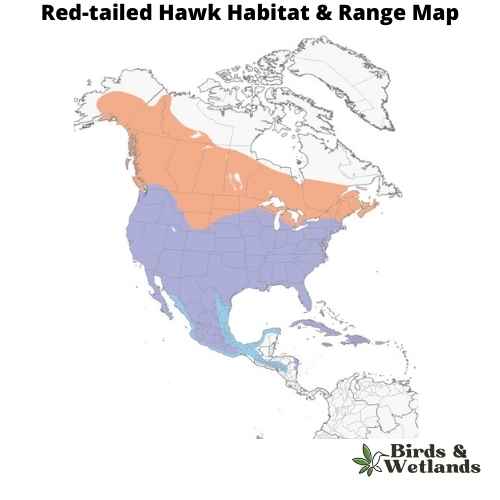
Red-tailed Hawk Sound
Red-shouldered Hawk (Buteo lineatus)

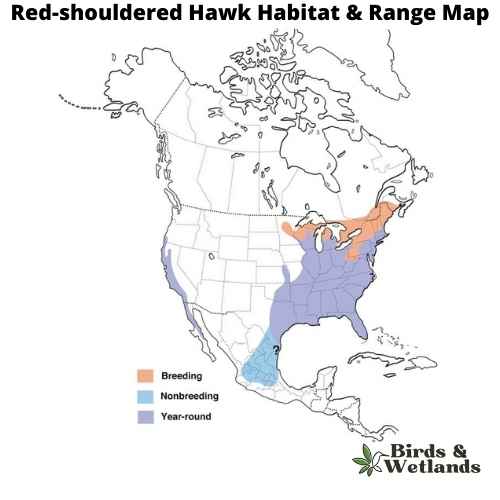
Listen:
The red-shouldered hawk are medium sized birds of prey, part of the buteo hawks family. It can be distinguished from other hawks by its reddish iris and pale legs.
The adult has rusty red upperparts, white underparts, a black chin and throat, and a reddish brown stripe over each eye, reddish brown heads and a strongly banded tail. The tail is reddish brown with two paler bands across it and they have white checkered wings. Juveniles are brown with dark barring and have pale fringes on the feathers of their wings.
Red-shouldered hawks nest in trees, though they also inhabit manmade structures including barns, bridges, and buildings. They prefer wooded areas with an open canopy but will use other places as well for nesting such as shrubs and hedges if needed.
The red-shouldered hawk’s diet – they eat small mammals such as ground squirrels, rabbits, voles, mice and rats. They also eat birds such as quail, pigeons and doves; reptiles including snakes; amphibians; fish; crustaceans; insects; and carrion (dead animals).
Cooper’s Hawk (Accipiter cooperii)

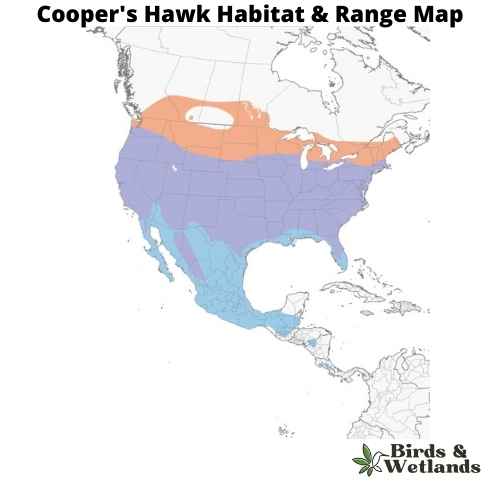
Listen:
The Cooper’s Hawk is a medium-sized bird of prey native to North America. Known for its agility and speed, it is part of the Accipitridae hawk species, which also includes other hawks, eagles, and kites.
Cooper’s Hawks are typically about 14 to 20 inches in length, with a wingspan ranging from 27 to 36 inches. They are known for their distinctive long, rounded tails and short, rounded wings. They have a steely blue gray top, with rusty bars on their underparts and thick, dark bands on their tails.
The Cooper’s Hawk is a skilled predator, primarily hunting birds and small mammals. They are adept at hunting in both dense forests and open areas, often catching prey mid-air in high-speed pursuits. They have also been known to visit the backyard bird feeder, not for the seed, but to prey on the smaller birds that gather there.
Cooper’s Hawks often build nests in dense tree canopies where they are well concealed. The female usually lays 3 to 5 eggs, and both parents share incubation duties. The young hawks fledge after about a month but will stay close to the nest, relying on their parents for food as they learn to hunt.
Sharp-shinned Hawk (Accipiter striatus)

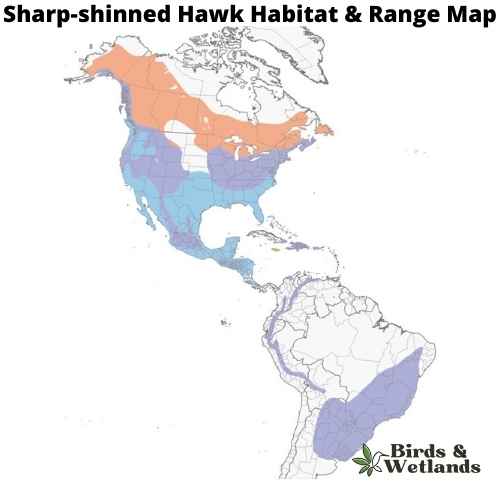
Listen:
The adult bird is brown on top and white underneath, with a dark brown band across its chest. It has short, rounded wings and a long tail that makes it look larger than it actually is. Adult sharp shinned hawks have black eyes, which are surrounded by white feathers. The female Sharp-shinned Hawk is browner than the male, who has darker brown markings on his back.
Sharp-shinned Hawks prefer open country for their habitat, including fields and meadows where they can hunt for mice and other small animals. They can be found throughout the United States but are most common in the east.
Sharp-shinned Hawks eat mostly small birds, such as sparrows and warblers, as well as small mammals such as mice and gophers. They catch prey by surprise using their incredible speed and agility, diving out of the sky at speeds up to 200 mph.
Sharp-shinned Hawks have an unusual hunting style for hawks—they prefer to catch their prey from perches above trees or telephone wires, rather than swooping down from above like most other hawks do and can often be seen hunting near bird feeders.
Broad-winged Hawk (Buteo platypterus)

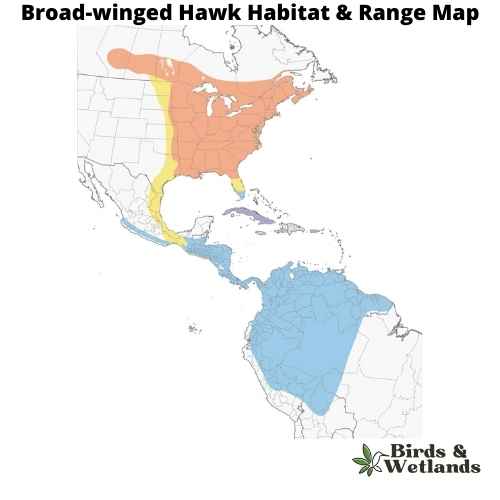
Broad-winged Hawk Sound
The Broad-winged Hawk holds a commanding presence as one of the largest hawks in the world, known for its broad wings. Its formidable size is a testament to its prowess as a bird of prey, effortlessly navigating the open skies in search of food.
Their distinctive appearance sets them apart. The adults exhibit a striking black and white pattern, complemented by a rusty breast and buff underparts and brown wings. In contrast, juveniles are adorned with a brown plumage, marked by pale edges on their feathers, adding to their distinctive youthful charm.
These hawks are most commonly found in open areas, such as farmlands or grasslands interspersed with scattered trees, which provide optimal conditions for when hawks hunt.
When it comes to their diet, Broad-winged Hawks feed on small rodents like mice, rats, squirrels, rabbits, and voles. Broad winged hawks breed during the spring and summer months then migrate to central and south America.
Swainson’s Hawk (Buteo swainsoni)
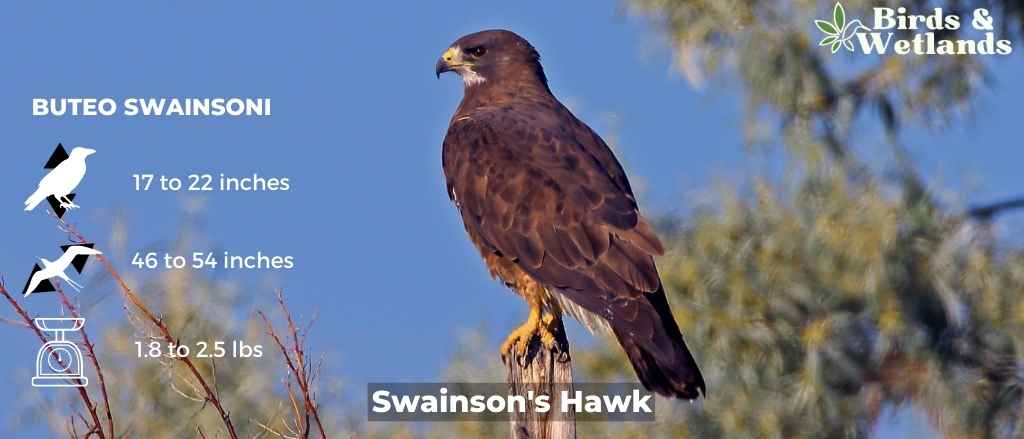
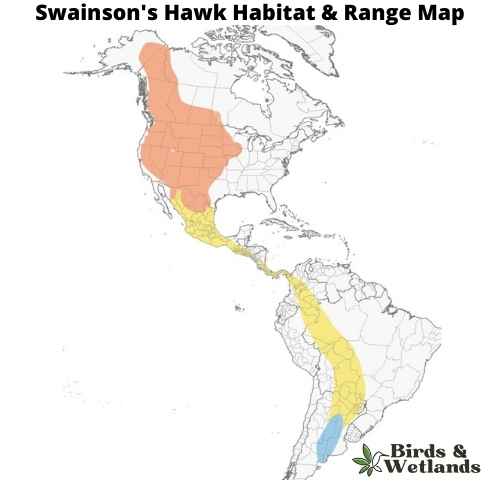
Listen: Swainson’s Hawk
Swainson’s Hawk is a medium-sized hawk that is found in North America and South America, Scientific Name: Buteo swainsoni.
The bird has a blue-gray plumage with a dark brown back, wings, and tail. It also has a white chest and belly. The beak and feet are black, but the eyes are yellow. They are often confused with Cooper’s Hawk because of similar coloring, but Swainson’s Hawks have wider tails and longer wings than their cousin species.
These birds eat small rodents such as gophers and mice. They also eat insects like grasshoppers and crickets during the summer months when they’re plentiful. They sometimes steal prey from other birds of prey such as Northern Harriers who hunt the same prey.
Swainson’s Hawks build nests on rocky cliffs near water sources where they can find food easily. They lay three to five eggs that hatch after about two months into fluffy brown baby hawks who leave the nest after about three weeks (or when they’re big enough).
Northern Harrier (Circus hudsonius)

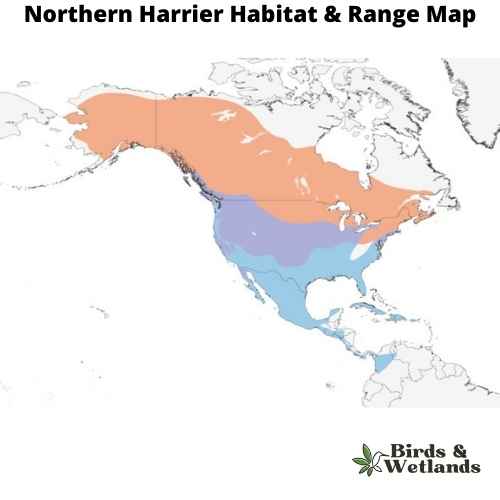
Listen:
The Northern Harrier is a medium-sized, slender hawk.
Adult birds are gray above, with pale bars on the wing feathers and white markings on the underwings and a white rump patch. The breast is barred with black and white, and the belly is streaked with brown.
They prefer open areas, such as grasslands and marshes, but can be found in almost any open habitat except dense woods.
Northern Harriers are opportunistic hunters that feed on small mammals such as mice, voles and rabbits as well as birds including quail, grouse and ducks. They hunt by flying low over open spaces such as fields or marshes.
Northern harrier nests on the ground in lowlands or hillsides near water bodies. It lays two to four eggs which hatch after 24 days of incubation by both parents. The chicks fledge after 30 days of hatching and remain dependent on their parents for another three weeks during which they learn how to fly.
Rough-legged Hawk (Buteo lagopus)

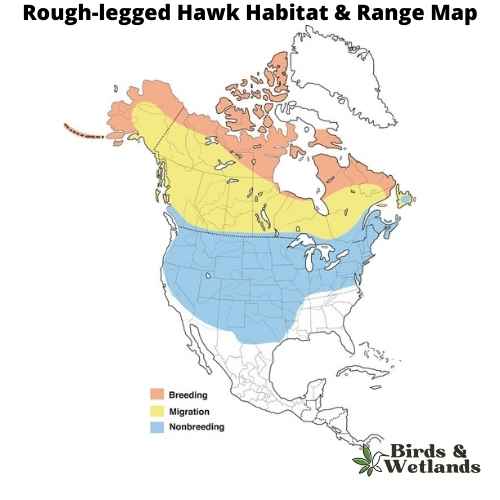
Rough-legged Hawk Sound
The Rough-legged Hawk is a large, raptor that is native to North America. It is also known as the American Rough-legged Hawk. Scientific Name: Buteo lagopus
The Rough-legged Hawk is a medium-sized hawk with a distinctive appearance, with dark brown feathers on its back and light brown feathers on its underside and broad thin wings. The hawk’s legs are also covered in dark feathers, which help to distinguish it from other species of hawk. The tail is barred with black and white. They have yellow eyes and dark feet.
Rough-legged Hawks hunt from above ground level, swooping down to catch its prey in its talons. When hunting for food, they prefer to eat small mammals such as squirrels and rabbits but will also eat birds if there aren’t any small mammals available. Although they eat a variety of small animals including birds, rodents, bats and reptiles, they rely heavily on fish for food during breeding season because it provides them with protein and calcium needed to produce eggs.
Ferruginous Hawk (Buteo regalis)

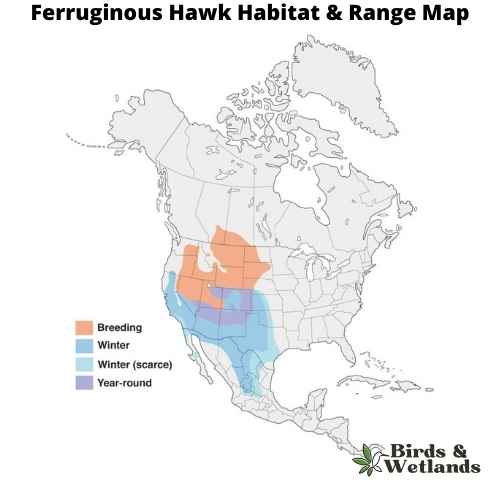
Ferruginous Hawk Sound
Scientific Name: Buteo regalis
Length: 20 to 27 in
Wingspan: 48 to 60 in
Weight: 32.0 to 80.0 oz
The Ferruginous Hawkis the largest hawk species native to North America. Known for its distinctive coloration and impressive size, this bird of prey predominantly inhabits the open landscapes of the western United States and parts of Canada.
Ferruginous Hawks are notable for their “ferruginous” or rust-colored back and shoulders, which contrasts sharply with the bird’s white underside. The hawk also has broad, rounded wings and a large, gape-mouthed beak. Ferruginous hawks exhibit dark morph and light morphs. Dark morphs have dark brown plumage, while light morphs display lighter, reddish-brown plumage. Morphs vary geographically.
Primarily feeding on small to medium sized mammals like rabbits and prairie dogs, the Ferruginous Hawk is an agile hunter, often seen soaring high above the ground or perched prominently while scanning for prey. It occasionally feeds on birds, reptiles, and insects as well.
Nesting for Ferruginous Hawks typically occurs on cliffs, hillsides, or large trees. The female lays between 2 to 5 eggs, and both parents share in the incubation and rearing of the chicks. The Ferruginous Hawk is a relatively solitary bird outside of the breeding season, and its call is a loud, high-pitched scream, often heard during courtship or near the nest.
Northern Goshawk (Accipiter gentilis)


Listen:
The Northern Goshawk is a medium-sized hawk that is found in North America, Europe and Asia. It has brown eyes, a large sharp beak, and dark brown plumage on its upperparts and head, with white underparts that are spotted with brown barring. Its tail feathers are grayish-black with a dark band near the tip.
Northern goshawks eat squirrels, rabbits, grouse, woodchucks and other small mammals like voles or mice (which they often eat whole). They will also take larger prey such as deer fawns or even adult deer if they have no other choice. They have broad wings with long feathers that allow them to glide through the air when they catch their prey. They also have an excellent sense of smell which helps them locate their food source.
The Northern Goshawk builds its nest in a tree cavity or on a ledge, usually on the edge of an open area so it can easily see prey below. The female lays 3 to 5 eggs over two days and incubates them for 28 to 30 days while the male brings food to her every few hours until they hatch. The young fledge after about 6 weeks and leave the nest when they are about 10 weeks old.
FAQs About Hawks in Arkansas
Can I keep a hawk as a pet in Arkansas?
No, it is illegal to keep hawks or any other native birds of prey as pets in Arkansas. These birds are protected under state and federal laws to ensure their conservation and well-being in their natural habitats.
What threats do hawks face in Arkansas?
Hawks in Arkansas face various threats, including habitat loss, pesticide contamination, and collisions with man-made structures like buildings and vehicles. Conservation efforts aim to mitigate these threats and protect hawk populations.
How can I attract hawks to my backyard in Arkansas?
To attract hawks, it’s essential to provide a suitable habitat. Create a diverse landscape with trees, shrubs, and open spaces to offer perching and hunting opportunities. Additionally, providing bird feeders that attract smaller birds can increase the chances of hawks visiting your backyard.
What should I do if I find an injured or orphaned hawk in Arkansas?
If you encounter an injured or orphaned hawk, it’s important to contact a licensed wildlife rehabilitator in Arkansas. They have the expertise and resources to assess and provide appropriate care for the bird, increasing its chances of recovery and eventual release back into the wild.


